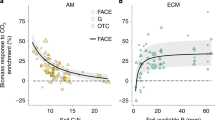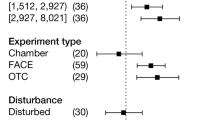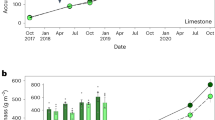Abstract
The stimulation of plant growth by elevated CO2 concentration has been widely observed. Such fertilization, and associated carbon storage, could dampen future increases in atmospheric CO2 levels and associated climate warming1. However, the CO2 fertilization of plant biomass may be sensitive to nitrogen supply2,3,4. Herein we show that in the latest decade of a long-term perennial grassland experiment, low ambient soil nitrogen availability constrained the positive response of plant biomass to elevated CO2, a result not seen in the first years (1998–2000) of the study. From 2001 to 2010, elevated CO2 stimulated plant biomass half as much under ambient as under enriched nitrogen supply, an effect mirrored over this period by more positive effects of elevated CO2 on soil nitrogen supply (net nitrogen mineralization) and plant nitrogen status under enriched than ambient nitrogen supply. The results did not strongly support either the progressive nitrogen limitation hypothesis, or the alternative hypothesis of priming of soil nitrogen release by elevated CO2. As nitrogen limitation to productivity is widespread, persistent nitrogen constraints on terrestrial responses to rising CO2 are probably pervasive. Further incorporation of such interactions into Earth system models is recommended to better predict future CO2 fertilization effects and impacts on the global carbon cycle.
This is a preview of subscription content, access via your institution
Access options
Subscribe to this journal
Receive 12 print issues and online access
$209.00 per year
only $17.42 per issue
Buy this article
- Purchase on Springer Link
- Instant access to full article PDF
Prices may be subject to local taxes which are calculated during checkout



Similar content being viewed by others
References
IPCC Climate Change 2007: The Physical Science Basis (eds Solomon, S. et al.) (Cambridge Univ. Press, 2007).
Hungate, B. A., Dukes, J. S., Shaw, M. R., Luo, Y. Q. & Field, C. B. Nitrogen and climate change. Science 302, 1512–1513 (2003).
Oren, R. et al. Soil fertility limits carbon sequestration by forest ecosystems in a CO2 enriched world. Nature 411, 469–472 (2001).
Schneider, M. K. et al. Ten years of free-air CO2 enrichment altered the mobilization of N from soil in Lolium perenne L. swards. Glob. Change Biol. 10, 1377–1388 (2004).
Reich, P. B. et al. Nitrogen limitation constrains sustainability of ecosystem response to CO2 . Nature 440, 922–925 (2006).
Inauen, N., Korner, C. & Hiltbrunner, E. No growth stimulation by CO2 enrichment in alpine glacier forefield plants. Glob. Change Biol. 18, 985–999 (2012).
Luo, Y., Hui, D. & Zhang, D. Elevated CO2 stimulates net accumulations of carbon and nitrogen in land ecosystems: A meta-analysis. Ecology 87, 53–63 (2006).
Sokolov, A. P. et al. Consequences of considering carbon/nitrogen interactions on the feedbacks between climate and the terrestrial carbon cycle. J. Clim. 21, 3776–3796 (2008).
Thornton, P. E. et al. Carbon–nitrogen interactions regulate climate-carbon cycle feedbacks: Results from an atmosphere–ocean general circulation model. Biogeosciences 6, 2099–2120 (2009).
Langley, J. A. & Megonigal, J. P. Ecosystem response to elevated CO2 levels limited by nitrogen induced plant species shift. Nature 466, 96–99 (2010).
McCarthy, H. R. et al. Re-assessment of plant carbon dynamics at the Duke CO2 free-air enrichment site: Interactions of atmospheric [CO2] with nitrogen and water availability over stand development. New Phytol. 185, 514–528 (2010).
Esser, G., Kattge, J. & Sakalli, A. Feedback of carbon and nitrogen cycles enhances carbon sequestration in the terrestrial biosphere. Glob. Change Biol. 17, 829–842 (2011).
Reich, P. B., Hungate, B. A. & Luo, Y. Carbon–nitrogen interactions in terrestrial ecosystems in response to rising atmospheric carbon dioxide. Ann. Rev. Ecol. Evol. Syst. 37, 611–636 (2006).
Norby, R. J., Warren, J. M., Iversen, C. M., Medlyn, B. E. & McMurtrie, R. E. CO2 enhancement of forest productivity constrained by limited nitrogen availability. Proc. Natl Acad. Sci. USA 107, 19368–19373 (2010).
Rastetter, E. B., Agren, G. I. & Shaver, G. R. Responses of N-limited ecosystems to increased CO2: A balanced-nutrition coupled-element-cycles model. Ecol. Appl. 7, 444–460 (1997).
Zak, D. R., Pregitzer, K. S., Curtis, P. S. & Holmes, W. E. Atmospheric CO2 and the composition and function of soil microbial communities. Ecol. Appl. 10, 47–59 (2000).
Luo, Y. et al. Progressive nitrogen limitation of ecosystem responses to rising atmospheric carbon dioxide. Bioscience 54, 731–739 (2004).
Gill, R. A. et al. Nonlinear grassland responses to past and future atmospheric CO2 . Nature 417, 279–282 (2002).
Dukes, J. S. et al. Responses of grassland production to single and multiple global environmental changes. PLoS Biol. 3, e319 (2005).
Finzi, A. C. & Schlesinger, W. H. Soil–nitrogen cycling in a pine forest exposed to 5 years of elevated carbon dioxide. Ecosystems 6, 444–456 (2003).
Dijkstra, F. A. et al. Long-term enhancement of N availability and plant growth under elevated CO2 in a semi-arid grassland. Funct. Ecol. 22, 975–982 (2008).
Langley, J. A. et al. Priming depletes soil carbon and releases nitrogen in a scrub-oak ecosystem exposed to elevated CO2 . Soil Biol. Biochem. 41, 54–60 (2009).
Phillips, R. P., Bernhardt, S. S. & Schlesinger, W. H. Elevated CO2 increases root exudation from loblolly pine (Pinus taeda) seedlings as an N-mediated response. Tree Physiol. 29, 1513–1523 (2009).
Phillips, R. P., Finzi, A. C. & Bernhardt, E. S. Enhanced root exudation induces microbial feedbacks to N cycling in a pine forest under long-term CO2 fumigation. Ecol. Lett. 14, 187–194 (2011).
Drake, J. E. et al. Increases in the flux of carbon belowground stimulate nitrogen uptake and sustain the long-term enhancement of forest productivity under elevated CO2 . Ecol. Lett. 14, 349–357 (2011).
Carney, K. M., Hungate, B. A., Drake, B. G. & Megonigal, J. P. Altered soil microbial community at elevated CO2 leads to loss of soil carbon. Proc. Natl Acad. Sci. USA 104, 4990–4995 (2007).
Adair, E. C., Reich, P. B., Hobbie, S. E. & Knops, J. M. H. Interactive effects of time, CO2, N, and diversity on total belowground carbon allocation and ecosystem carbon storage in a grassland community. Ecosystems 12, 1037–1152 (2009).
Hobbie, S. E. Nitrogen effects on decomposition: A five-year experiment in eight temperate sites. Ecology 89, 2633–2644 (2008).
Lee, T. D., Barrott, S. H. & Reich, P. B. Photosynthetic responses of 13 grassland species across 11 years of free-air CO2 enrichment is modest, consistent and independent of N supply. Glob. Change Biol. 17, 2893–2904 (2011).
Reich, P. B. et al. Impacts of biodiversity loss escalate as redundancy fades. Science 336, 589–592 (2012).
Acknowledgements
This work was supported by the US Department of Energy (DOE/DE-FG02-96ER62291 and DE-FC02-06ER64158) and the National Science Foundation (NSF Biocomplexity 0322057, NSF LTER DEB 9411972 (1994–2000), DEB 0080382 (2000–2006), and DEB 0620652 (2006–2012), and NSF LTREB 0716587) and the University of Minnesota.
Author information
Authors and Affiliations
Contributions
P.B.R. designed, orchestrated, coordinated and managed the implementation of the experiment; conducted the data analyses; and wrote the manuscript. S.H. assisted with all of these except the study design.
Corresponding author
Ethics declarations
Competing interests
The authors declare no competing financial interests.
Supplementary information
Supplementary Information
Supplementary Information (PDF 281 kb)
Rights and permissions
About this article
Cite this article
Reich, P., Hobbie, S. Decade-long soil nitrogen constraint on the CO2 fertilization of plant biomass. Nature Clim Change 3, 278–282 (2013). https://doi.org/10.1038/nclimate1694
Received:
Accepted:
Published:
Issue Date:
DOI: https://doi.org/10.1038/nclimate1694
This article is cited by
-
Mycorrhizal type regulates trade-offs between plant and soil carbon in forests
Nature Climate Change (2024)
-
Synergistic effects of leaf nitrogen and phosphorus on photosynthetic capacity in subtropical forest
Theoretical and Experimental Plant Physiology (2024)
-
Reduced phosphorus availability in paddy soils under atmospheric CO2 enrichment
Nature Geoscience (2023)
-
Grassland responses to elevated CO2 determined by plant–microbe competition for phosphorus
Nature Geoscience (2023)
-
Competing for phosphorus
Nature Geoscience (2023)



